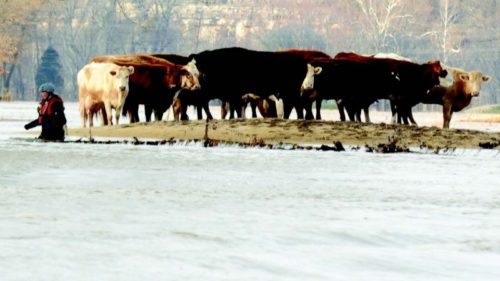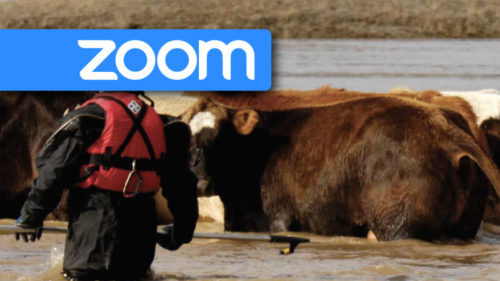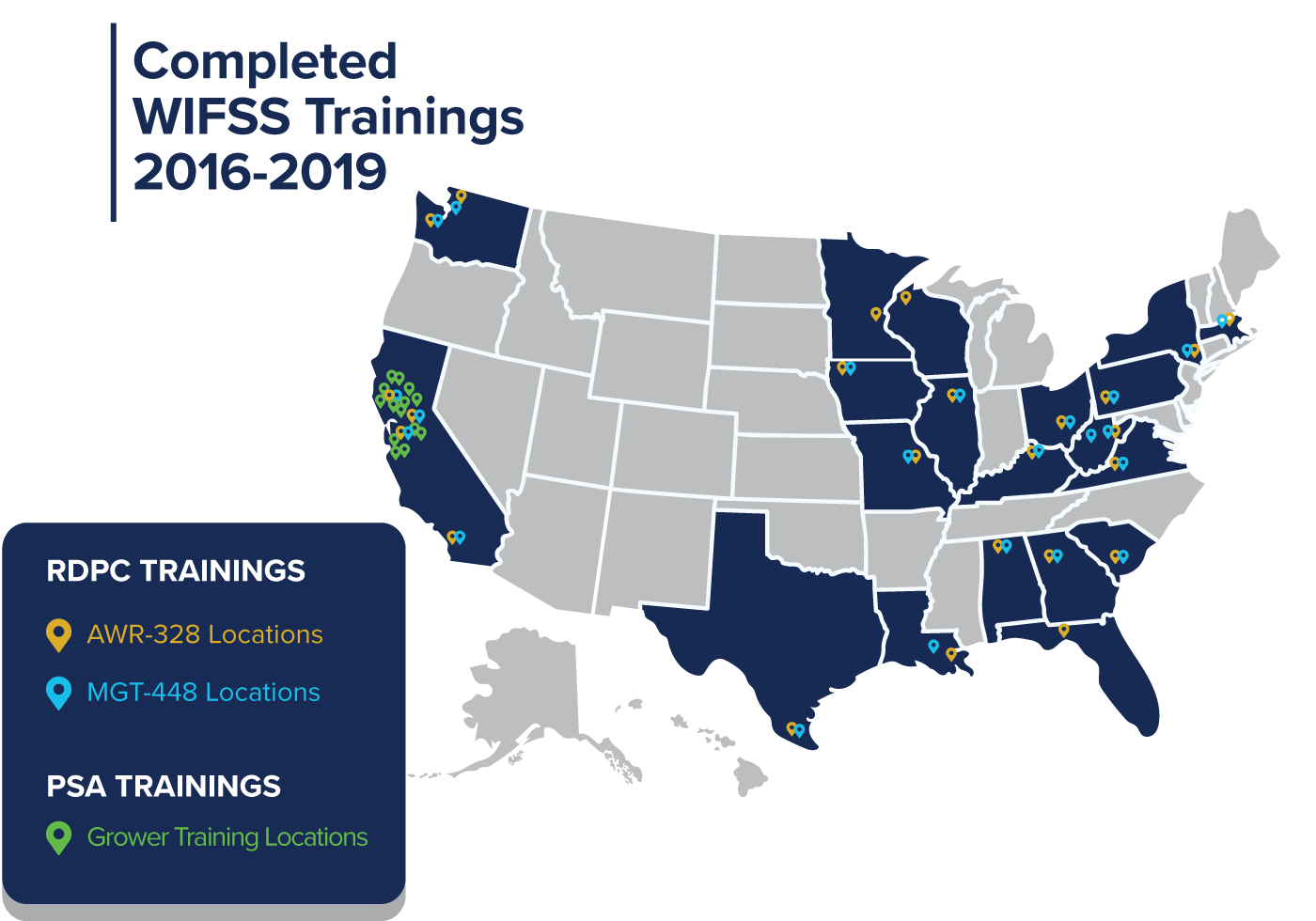
Overview
The Rural Domestic Preparedness Consortium (RDPC) realizes the nation’s rural and tribal emergency responders face unique challenges when compared to their urban counterparts. As such, RDPC is committed to providing small, rural, and tribal emergency responders and stakeholders with the knowledge, skills, and abilities necessary to enhance the safety, security, and quality of life for their citizens through access to DHS certified training and resources developed specifically for rural practitioners and communities.
RDPC is leading the rural first responder training initiative by developing courses that are created using a rigorous, standardized curriculum development process that ensures consistency with the principles and priorities set forth by the National Preparedness System (NPS) and the National Incident Management System (NIMS). Once complete, the curriculum is certified and authorized by the U.S. Department of Homeland Security (DHS) for delivery at no cost to tribal and rural communities nationwide.
To ensure that training directly reflects the needs of rural emergency responders, the Consortium convenes a national rural preparedness summit and completes a bi-annual national survey of rural stakeholders. Data gathered from these activities is used to determine the type of training needs, the extent to which it is needed, and the best delivery methods.

AWR 328 All Hazards Preparedness for Animals in Disasters
This course will provide livestock producers, emergency managers, veterinarians, extension agents, veterinary technicians, rural community leaders, public and human health personnel, fire and law enforcement with tools to protect, respond to, and recover from the consequences of disasters (e.g. fire, flood, heat, earthquake, tornadoes, hurricanes, hazardous materials and catastrophic disease exposure) involving animals in rural communities. The course will introduce participants to the unique issues that must be considered and addressed when animals are involved in an emergency such as safe animal handling, animal evacuation, animal sheltering, humane euthanasia, carcass disposal, inclusion of animal management into existing ICS structures, and federal support available during recovery.
Course Registration
Register for a class below. Select a class date from the DHS Certified Training Classes, and click to access a registration form for that class. Request a new class to be scheduled in your area by submitting a Request a Course form.
Course Prerequisites
*Participants must be U.S. citizens

AWR 328-V All Hazards Preparedness for Animals in Disasters
This 8-hour awareness-level course is delivered in two 4-hour Zoom sessions and is designed to provide livestock producers, emergency managers, veterinarians, extension agents, veterinary technicians, rural community leaders, public and human health personnel, fire and law enforcement with tools to protect, respond to, and recover from the consequences of disasters (e.g. fire, flood, heat, earthquake, tornadoes, hurricanes, hazardous materials, and catastrophic disease exposure) involving animals in rural communities. The course will introduce participants to the unique issues that must be considered and addressed when animals are involved in an emergency such as safe animal handling, animal evacuation, animal sheltering, humane euthanasia, carcass disposal, inclusion of animal management into existing ICS structures, and federal support available during recovery.
Course Registration
Register for a class below. Select a class date from the DHS Certified Training Classes, and click to access a registration form for that class. Request a new class to be scheduled in your area by submitting a Request a Course form.
Course Prerequisites
*Participants must be U.S. citizens

MGT 448 All Hazards Planning for Animal, Agricultural, and Food Related Disasters
This course will provide the background information needed to lead a multi-agency team of emergency planners in the development of an ESF annex for food and/or animal related disasters to supplement their community’s existing EOP. The course will address topics such as agroterrorism; detection and diagnosis; the unique challenges that rural communities face in planning for and responding to food and/or animal related disasters; utilization of Emergency Support Functions (ESF); recovery and the importance of sustainable operations during a disaster event; and mapping a community to identify areas of vulnerability and resources. All content will be presented at an all-day instructor led training that will include presentations and problem-solving activities that will be worked on in small groups.
Course Registration
Register for a class below. Select a class date from the DHS Certified Training Classes, and click to access a registration form for that class. Request a new class to be scheduled in your area by submitting a Request a Course form.
Course Prerequisites
* Participant must be a U.S. citizen AWR 328: All Hazards Preparedness for Animals in Disasters

MGT 448-V All Hazards Planning for Animal, Agricultural, and Food Related Disasters
This course will provide the background information needed to lead a multi-agency team of emergency planners in the development of an ESF annex for food and/or animal related disasters to supplement their community’s existing EOP. The course will address topics such as agroterrorism; detection and diagnosis; the unique challenges that rural communities face in planning for and responding to food and/or animal related disasters; utilization of Emergency Support Functions (ESF); recovery and the importance of sustainable operations during a disaster event; and mapping a community to identify areas of vulnerability and resources. All content will be presented at an all-day instructor led training that will include presentations and problem-solving activities that will be worked on in small groups.
Course Registration
Register for a class below. Select a class date from the DHS Certified Training Classes, and click to access a registration form for that class. Request a new class to be scheduled in your area by submitting a Request a Course form.
Course Prerequisites
* Participant must be a U.S. citizen AWR 328: All Hazards Preparedness for Animals in Disasters
Past In-Person Courses
AWR 151 is designed to educate and enable the diverse elements that must be called upon to participate in creating an effective response plan. The course will educate by using specific examples to demonstrate the potential effects of possible types of agroterrorism. It will demonstrate how preplanning can create an effective community response that will reduce or mitigate individual acts of terror. Individuals who have completed this course will be enabled to invest their agency or individual resources to develop or strengthen a community plan.
AWR 152 is designed to prepare members of emergency response teams to evaluate the overall risk of an intentional attack on a segment of agriculture or a segment of the food system and to provide information about methods to limit vulnerabilities in identified targets. Participants will learn to evaluate the impact of an incident on the entire food system (food continuum) or on a specific segment of the food system. The course will also provide information to enable participants to more clearly understand the threats that are posed to agriculture and the food system. Emergency response team personnel will develop skills to assess vulnerabilities and identify targets to assist in preventing or mitigating an intentional attack on the agriculture or food system.
Informs frontline response teams about the importance of early detection and diagnosis, proper sampling, and steps involved in an agroterrorism‐related outbreak investigation. Provides strategies to increase detection and diagnosis efficiency, as well as the epidemiological and criminal investigation process. This is the third of six courses in the WIFSS Agroterrorism Preparedness Curriculum for Frontline Responders series.
AWR 154 is designed to convey best practices, concepts, organizational procedures, and terminology that make up the framework of ICS and NIMS. The course will further enhance community response capacity to an agricultural or food systems disaster by improving participants’ understanding of interagency collaboration through team building and the principles of effective risk communication. The team-building module enhances preparedness by improving participants’ ability to work across organizational borders. By providing participants with information on the principles of risk communication against the backdrop of NIMS, local emergency responders will understand risk communication as both a concept and an application.
AWR 155 outlines the use of the Incident Command System (ICS) and the principles of Unified Command (UC) in a agroterrorism and food safety system disaster. Participants will apply ICS and UC principles through various exercises. Participants will be enabled to form and maintain frontline emergency response teams in response to such emergencies. The course will raise awareness to the need to quickly identify and eradicate outbreaks of animal diseases by isolating and destroying livestock and wildlife, removing and disposing of contaminated animal products, and disposing of contaminated feed and related materials. This course will also address the need for whole community preparedness and participation by strengthening local citizen emergency response teams which can support surge capacity response to an agricultural or food systems emergency or act of agroterrorism.
AWR 156 provides the fundamental framework for orchestrating the recovery from an incident of agroterrorism or food systems disaster. It defines recovery, the community stakeholders who must participate in the recovery, and the activities involved in restoring public confidence and a sense of normalcy. This course provides specific steps for planning for recovery, both within participants’ own organizations and as stakeholders in the larger community-wide incident command system. Using the lessons learned from the preceding courses in the curriculum series, this course will train members of the agriculture community on recovery operations, procedures, and techniques to be implemented following an incident of agroterrorism.

